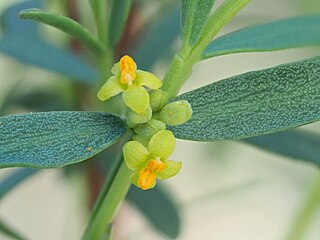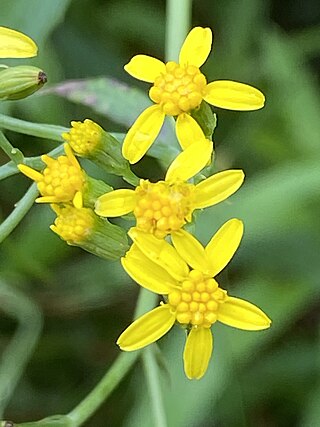
Howittia is a genus of plant containing the single species, Howittia trilocularis, commonly known as blue howittia, and is endemic to Australia. It is a tall shrub found growing in shaded valleys and on rainforest edges, it has hairy leaves and single, purple flowers.

Hypericum canariense is a species of flowering plant in the family Hypericaceae known by the common name Canary Islands St. John's wort. It is the sole member of Hypericumsect. Webbia.

Acrotriche depressa, commonly known as wiry ground-berry or honeypots, is a flowering plant in the family Ericaceae. It is a small shrub with crowded greyish-green leaves and white or green flowers and grows in southern Australia.

Melaleuca halmaturorum, commonly known as South Australian swamp paperbark, kangaroo honey-myrtle or salt paper-bark is a plant in the myrtle family, Myrtaceae and is endemic to Western Australia, South Australia and Victoria. It is often a tree with an unusual, crooked form, sometimes looking like an enlarged example of bonsai.

Dampiera stricta commonly known as blue dampiera, is a flowering plant in the family Goodeniaceae. It is a small sub-shrub with variable leaves and mostly blue, mauve or purple flowers.

Halgania cyanea, commonly known as rough halgania, is a species of flowering plant in the family Boraginaceae. It is a small perennial shrub with dull green leaves, bright blue flowers and is endemic to Australia.

Pyrorchis, commonly known as beak orchids, is a genus of flowering plants in the orchid family, Orchidaceae and is endemic to Australia. It contains two species which were previously included in the genus Lyperanthus, also known as beak orchids. Both species have fleshy, oval leaves and form colonies which flower profusely after bushfires.

Bolboschoenus is a genus of plants in the sedge family, of nearly cosmopolitan distribution. Epipaleolithic and Neolithic peoples used ground root tubers of these plants to make the first breads.

Scaevola albida, commonly known as pale fan-flower or small-fruit fan-flower, is a flowering plant in the family Goodeniaceae. It is a spreading perennial herb with pale blue or white fan-shaped flowers and obovate leaves. It grows in Queensland through eastern New South Wales and coastal areas of Victoria and Tasmania.

Eucalyptus leptophylla, commonly known as the March mallee, slender-leaved red mallee or narrow-leaved red mallee, is a species of mallee that is endemic to inland Australia. It has smooth greyish bark, linear to narrow lance-shaped, oblong or curved adult leaves, flower buds in groups of between seven and thirteen, creamy white flowers and cup-shaped, barrel-shaped or hemispherical fruit.

Pimelea pauciflora, commonly known as poison rice-flower, is a species of shrub in the family Thymelaeaceae. It has small yellow-lime flowers and green, smooth fleshy leaves, and is endemic to Eastern Australia.

Pterostylis vittata, commonly known as the banded greenhood or green-banded greenhood, is a plant in the orchid family Orchidaceae and is endemic to the south-west of Western Australia. The plants either have a rosette of leaves on a short stalk in the years when not flowering or stem leaves on a flowering spike. When flowering, it has up to about twenty five flowers which are translucent green with darker green stripes. It was formerly thought to occur in South Australia and Victoria but those collections are now thought to be of Pterostylis sanguinea.

Lobelia anceps, commonly known as angled lobelia, is a small herbaceous plant in the family Campanulaceae it grows in several states of Australia, New Zealand, South America and South Africa. It is a small, perennial herb with blue to purple flowers.
Wahlenbergia multicaulis is a small herbaceous plant in the family Campanulaceae native to Australia.
Baumea arthrophylla(now known as Machaerina arthrophylla) is a flowering plant in the sedge family, Cyperaceae that is native to many states and territories of Australia.
Bolboschoenus medianus is a flowering plant in the sedge family, Cyperaceae, that is native to Western Australia.

Senecio linearifolius, commonly known as fireweed groundsel, is a species of flowering plant in the family Asteraceae. It is a small shrub with variable leaves, numerous heads of yellow flowers and grows in Tasmania, New South Wales and Victoria.

Leucopogon attenuatus, commonly known as grey beard-heath, is a species of flowering plant in the family Ericaceae. It has grey-green leaves and small white flowers and grows in New South Wales and the Australian Capital Territory.

Scaevola depauperata, commonly known as skeleton fan-flower, is a species of flowering plant in the family Goodeniaceae. It is a small understorey shrub with blue, mauve or cream-white flowers. It grows in mainland states of Australia with the exception of Western Australia.
Cratystylis conocephala, the blue bush daisy, blue bush, grey bush, and round leaved greybush, is a species of flowering plant in the family Asteraceae, native to southeast Western Australia, South Australia, New South Wales, and Victoria. It is a densely branched, spreading shrub. The species is listed as endangered in New South Wales and critically endangered in Victoria.

















